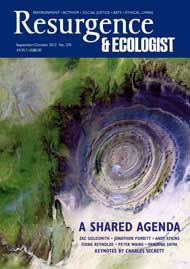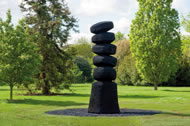Nestled in the grounds of London’s Kew Gardens, sculptor David Nash can be found at work up a hydraladder transforming a deceased oak tree into one of his latest creations. Nash, who could easily be mistaken for one of the garden’s arborists, reveals the process of making his sculptures to the public for the first time in his on-site ‘wood quarry’ as part of the interactive year-long exhibition David Nash at Kew: A Natural Gallery. Interspersed between eruptions of a roaring chainsaw, bouts of thundering rain and screeching peacocks, I managed to talk to Nash about his work and current exhibition as artist-in-residence at Kew.
Nash emerged in the late 1970s as one of a generation of well-known British sculptors, including Richard Long, Tony Cragg and Richard Deacon, who have a distinctly holistic approach to their craft and mastership of materials. Since leaving London in 1970 after attending numerous art colleges, Nash has been based in Blaenau Ffestiniog in North Wales, a location ideal for sourcing his earthly materials. “I wanted to pick stuff up off the ground, so my rule was that my work wasn’t going to cost anything. Initially it was scavenging.” The sustainable sourcing of materials is of great importance to Nash, so he only uses damaged or moribund trees: “I am using direct material and I only use it when it becomes available through natural processes, when the trees come to the end of their natural life, like this oak here.”
Although Kew Gardens is not a conventional arts venue, its sheer size is enough to suggest just how major this exhibition is. With 121 hectares of gardens and botanical glasshouses, Kew is an internationally renowned botanical research and education institution at the forefront of plant science and conservation. Here an artist with an extraordinary knowledge and familiarity with trees is working amongst botanists and dendrologists in a unique combination of art and science, bringing about a groundbreaking exhibition of interdisciplinary fascination.
As in every one of Nash’s sculptures, Kew Gardens is where the presence of the human being is very strong. Nash states: “These trees would not be here without the mindfulness of the human being and the learning and knowledge that human beings have accumulated about trees; and my work is about that sort of interface as well, being hands-on with that source of material.” Within the gardens all the trees are recognised, labelled and decisively pruned and protected: “They are all known.” Nash expresses great delight being in close proximity to his subjects and having the opportunity to study his materials in a different way, such as observing wood through a microscope, as well as discovering the ways in which different woods respond to being carbonised.
The context in which the work is seen is of great importance, and here Nash has the opportunity to show his work in the environment from which it came. Kew’s Temperate House, the largest surviving Victorian glasshouse in the world and home to an impressive array of plant species, is currently also home to 18 of Nash’s sculptures. Like a treasure hunt, wandering around the glasshouse scouting out the sculptures amongst the foliage is an extraordinary and novel experience. Placed amongst their natural counterparts, they are without labels or other accompanying information. They exude a sense of belonging, purely visual and existential. In contrast to the conventional gallery-orientated experience of art, here is the potential for people to encounter these unusual objects almost unexpectedly. Nash explains: “People can go into the Temperate House and just look at plants and not be bothered by my sculptures at all. That’s what I really like.”
Nash’s working method involves hewing, carving and charring wood using chainsaws, axes and fire. Trees are marked by the artist’s hand. However, the aesthetic is already largely there; it just requires the artist’s sagacity and skill to give it meaning. Nash allows Nature to suggest and dictate the direction his creations take, honouring the natural contours and characteristics of the wood. A clear demonstration of the mark of a human, but in a way that works with Nature.
This is a practical and visual philosophy – a powerful reminder of a working relationship between people and Nature in a dialogue of wills. Nash alludes to our reliance upon Nature as a source for materials: throughout the ages, we have depended on wood as a material for building, burning and cooking. An example of how Nature – the essence of our existence – caters for us spiritually and practically.
For many of his sculptures, Nash chars the wood to create an intense yet deeply soft and palpable surface. The blackness of the charred wood absorbs light and encourages viewers to observe its form rather than the detail of the wood’s surface, thereby changing their experience of the object. Nash explains: “When you char a piece of wood, you’re not really experiencing wood any more. You’re experiencing the element of carbon, so you see the form before the wood. When it’s not charred, you see the wood before the form.”
Working with wood has led Nash’s interest in the science and anthropology of trees with a deeper understanding of their properties, from their fundamental amalgamation of the elements (earth, air, fire and water) to their engineering and individual uniqueness. Nash describes beech as having a heavy moist quality, an emotional coolness; oak, as having an emotional warmth; and elm, a curious rubberiness. “It’s the moisture content that I can feel more than anything else, because it’s a solid material. It’s almost like the flavour of a cordial; I can almost taste them just by looking at them.” As emblems for life, Nash describes trees as having a profound wisdom: “Trees are so resilient and their intention to live is phenomenal.”
Keen to avoid over-interpretation, he emphasises the basic level at which his work operates: “My work is about how much we need to do with stuff to live, so it’s very simple what I do; it’s very basic.” It is physical, elemental and visual. It is about presence – human and natural. Nash is interested in the process of conceiving and making art as a visual language for communication. “When we try to understand an object, we have to use our imagination, so we dig into our world experience, into our life experience, and that draws up associations. And I think that’s what I really enjoy about art, and that’s what artists do. That’s where the communication is.”
Within the grounds of Kew Gardens, Nash’s sculptures command the space in a beautifully organic and harmonious manner, assuming their natural place. The unusual yet starkly familiar elemental shapes of resonating geometric abstraction give his sculptures a natural force, affecting people across social and cultural boundaries. They are universal; they are perennial. The exhibition at Kew will be rejuvenated in October with the unveiling of works that have come out of the Wood Quarry in the preceding months. The inevitability of change will shape this exhibition over the course of the year, and, according to Nash, “it will go on starting and being, because I am here.”








